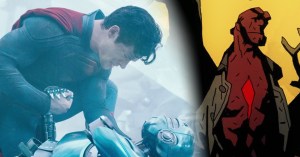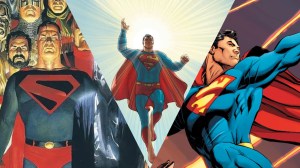DC began its latest Superman relaunch/reinvention this week with Brian Michael Bendis’ The Man of Steel, but it falls into a trap common to writers looking to pump some energy into the Superman titles: it is obsessed with Krypton. What it — and many Superman stories, frankly — fail to realize is that you do not need to reinvent Krypton again in order to understand Superman.
Videos by ComicBook.com
By writer Brian Michael Bendis‘s own admission, the sell for this story came when, in a phone call to DC co-publisher Dan DiDio, he asked whether anyone had ever written about “what really happened to Krypton.” DiDio was intrigued, asking Bendis what did happen to Krypton, and they were off to the races.
The result of that was Rogol Zaar, a villain who so far seems to be the central focus of Bendis’ Superman run. Zaar dominated Bendis and co-publisher Jim Lee’s Action Comics #1000 story, and began The Man of Steel #1 at center stage.
As far as we can tell, many years ago, Zaar — some kind of galactic enforcer for a mysterious group of powerful beings known as The Circle — pitched his bosses on the idea of killing all of the Kryptonians, since he viewed the planet as a threat. The Circle were not on board with his plans, but Appa Ali Apsa, the Mad Guardian of the Universe, was sympathetic to Zaar’s philosophy and encouraged him to go ahead without their blessing. And then shortly thereafter, Krypton exploded, which is something Zaar takes credit for.
Regardless of what DiDio might have told Bendis when he asked his question, the idea of who destroyed Krypton and why/how is fairly well-worn territory. It has been addressed numerous times throughout the character’s 80-year publishing history.
Obviously there is nothing wrong with adding previously undisclosed details to the backstory of a character like Superman. The Krypton revelation itself has been such a story thread over the years, with the earliest stories not particularly interested in Krypton’s identity beyond “doomed planet.”
That said, writers have gone back to the Krypton well quite a bit in recent years, usually with diminishing returns. Krypton was rebooted, along with the rest of Superman’s mythology, in the original The Man of Steel miniseries from writer/artist John Byrne. The changes he made were sweeping and radical, and while some longtime fans and other creators chafed at the alterations to canon, Byrne’s Krypton introduced a number of new characters and concepts that were popular enough that it has never been completely removed from the continuity.
Adjustments to Superman’s origin have been frequent in the years since, whether it be in Superman: Birthright (2003), Superman: Secret Origin (2009), The New 52 (2011), or Rebirth (2016). Usually those changes have been on a much smaller scale than Byrne’s reboot, and as often as not they have been aimed at replacing some element of pre-Byrne Krypton, resulting in a current Krypton that is a kind of patchwork of new and old looks, histories, mythologies, and technologies.
Since many of the particulars of Jor-El, the Kents, and Superman are more or less set in stone, each reinvention has followed Byrne’s lead and reinvented Krypton, so that when in Birthright DC established a “greatest hits” version of the universe where all of your favorite stories happened, Superman’s birth world was one of the most confusing elements of the whole deal.
Last year, Dan Jurgens wrote “The Oz Effect” in Action Comics, revealing that Mr Oz — an enigmatic villain who had been lurking around the periphery of the DC Univese for a few years — was in fact Jor-El, Superman’s biological father, saved from Krypton’s destruction at the last moment. It is not yet clear how, but it appears that story will tie into Geoff Johns and Gary Frank’s Watchmen sequel Doomsday Clock — which has already spoiled one of The Man of Steel‘s core mysteries.
“The Oz Effect” also seems likely to tie into the events of The Man of Steel, since Bendis’ Action Comics #1000 story saw Rogol Zaar claim that it was Jor-El who instructed him to destroy Krypton. There is no telling what shape that aspect of the story will take yet.
That is a lot of Krypton for a relatively short period of time, and we arent even counting things like Johns’s “New Krypton” storyline (2009) or SYFY’s Krypton TV series. With so many other facets of Superman’s mythology to explore, it might feel like overkill.
Superman, after all, is not genuinely Kryptonian, and putting too much emphasis on Krypton runs the risk of missing the point. The producers of Supergirl understand this, and have used it to their advantage: Kara came to Earth as a teenager, while Superman was a newborn. Krypton has only a marginal impact on who Superman is as a person.
“There are immigrants who turn their backs on their history and their culture,” General Zod told Seg-El in an episode of Krypton this season. “Passively accept the standards their new world offers as though no others could possibly exist.”
This is his uncharitable way of noting that Superman is a human and an American, not a Kryptonian. That is part of why Zod resents him, and believes “he let himself be cut down to size.”
To put it another way: “He’s more human than I am,” Batman told Wonder Woman in the Justice League movie. “He lived in this world, fell in love, had a job, despite all that power.”
This is why, ultimately, more insight into Krypton does not necessarily provide more insight into Superman: he is Clark Kent, the guy from Smallville, at his core. Krypton is the source of his powers, but what makes Superman special is that he is not defined by his powers.
Since Krypton does not define Superman, fixating too much on it, too often, can be off-putting for some fans. Even if it serves only as a source of villains or conflict, going back to that well too often can feel as uninspired as making every Flash villain the result of the same cosmic storm that gave him his powers.
At the end of the day, there is nothing really wrong with using Krypton as fodder for Superman stories — but there has been a lot of focus on it lately, and The Man of Steel‘s interest in it seems superficial enough to raise the question of why it had to be this way. By the end of its sixth weekly issues, it is distinctly possible it could delve into a deep enough mythology to make more sense — but even if so it feels like there may have been a better starting point for this latest Superman relaunch.





